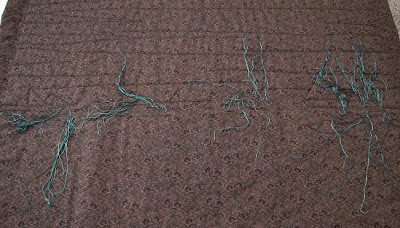After quilting in some easy lines in the background and much contemplation, I've started quilting the mountains in my sunset piece, beginning with the smaller blue ones. These are no higher than 2 inches, and the first try was a bust. I thought a dark thread would tone them down a bit but it only drew more attention to them, and in a bad way. The line of stitching around the outside of the shape didn't work either. So I defaulted to an Oliver Twist hand-dyed thread that I initially thought not dark enough. What I've determined is that mostly it is ok, and when it variegates too light, I can apply a little ink to even things out.
But because I wanted that clean even look, and some of the lines are very short, I decided I didn't want to do the starting and ending the line of stitching with very close stitching. No, I'm pulling thread tails to the back and burying them. Very time consuming but the only way to get the look I will be happy with. The last time I did this was on my Palouse pieces. At least it's a process that doesn't require any decision making!
I've made the same trial and error now that I'm quilting the orange mountains, and again, it was thinking I needed a darker thread than necessary. It worked on the triangles of print fabric but not on the main ones. I think I'm on the right track now, more tails to bury and more lines of stitching to put in. Why horizontal lines? Well, from the beginning, images from my trip through the Badlands of South Dakota popped into my head when the triangle offcuts lined up on my work table. I didn't need to go back to my reference pictures to check; throughout this design process, it was enough to call on memory. Everywhere I looked, I saw the exposed layers of sediment, unbroken lines.
And also everywhere, triangular shapes, scattered over otherwise flat plains.
Or grouped together.
The stitching itself, while not difficult and mostly along penciled-in lines, is taking longer than expected...all that starting and stopping. But once done, the rest of the background quilting should go quickly. I'm using Hobbs 80/20 black batting which is more like Warm & Natural cotton batting than Hobbs regular 80/20. The queen size batt I'm cutting from has major distortions and wrinkles which normally I would try to tame by spritzing with water and steaming with an iron held just above but not touching the surface. But neither trick was helping much. Then I remembered skimming an article where the instructions suggested ironing the batting first. Mmmm, could it be I needed to get that iron right on the batt? I covered it with a pressing cloth so the iron would glide over it and ramped up the steam. Wow - distortions and wrinkles pretty much gone and it has given me a very stable sandwich to work with.









1 comment:
I still think of them as sailboats, but I wouldn't have thought that before I moved here. Your photos help me accept that they are mountains.
Post a Comment